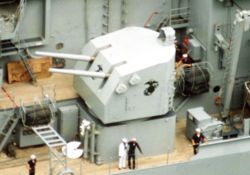Iowa-class: Difference between revisions
imported>Howard C. Berkowitz No edit summary |
mNo edit summary |
||
| (2 intermediate revisions by 2 users not shown) | |||
| Line 1: | Line 1: | ||
{{subpages}} | {{PropDel}}<br><br>{{subpages}} | ||
[[Image:USS Iowa (BB-61) broadside.jpg|thumb|left|300px|''USS Iowa (BB-61)'' firing full broadside from main and secondary batteries; note concussion waves on the water]] | [[Image:USS Iowa (BB-61) broadside.jpg|thumb|left|300px|''USS Iowa (BB-61)'' firing full broadside from main and secondary batteries; note concussion waves on the water]] | ||
U.S. '''Iowa-class'' [[battleship]]s were the last class of battleship to serve in combat. When they entered service late in the [[Second World War]], a few naval theorists suggest the exceptionally fast US ''Iowa-class'' battleships of [[World War II]] were really battlecruisers. Indeed, they were faster than the previous true [[South Dakota-class]] battleships and the planned [[Montana-class]] giants, but they had excellent armor. | U.S. '''''Iowa-class''''' [[battleship]]s were the last class of battleship to serve in combat. When they entered service late in the [[Second World War]], a few naval theorists suggest the exceptionally fast US ''Iowa-class'' battleships of [[World War II]] were really battlecruisers. Indeed, they were faster than the previous true [[South Dakota-class]] battleships and the planned [[Montana-class]] giants, but they had excellent armor. | ||
==Original design== | ==Original design== | ||
They had a main battery of three triple turrets with 16"/50 caliber guns, and, for the time, advanced fire control radar: it could be used to fight targets beyond visual range. The secondary battery consisted of 20 [[5"-38 caliber gun]] guns in dual mounts. [[Image:5in-38DualMount.jpg|thumb|right|250px|[[USMC]] crewed 5" | They had a main battery of three triple turrets with 16"/50 caliber guns, and, for the time, advanced fire control radar: it could be used to fight targets beyond visual range. The secondary battery consisted of 20 [[5"-38 caliber gun]] guns in dual mounts. [[Image:5in-38DualMount.jpg|thumb|right|250px|[[USMC]] crewed [[5"-38 caliber]] dual gun mount aboard the [[USS New Jersey (BB-62)]], 1984.]] | ||
Eventually, 20 quad mounted [[40mm-56 caliber gun]]s, 29 [[20mm Oerlikon (autocannon)|20mm]] single mounted autocannon, and several .50 caliber [[M2 machine gun]]s were added to thicken antiaircraft defense, requiring an additional 1,900 crew members. These were obsolete, however, by the end of the Second World War. While the 5" guns were retained for shore bombardment, the Iowas depended on other, more specialized missile-armed vessels for air defense. | Eventually, 20 quad mounted [[40mm-56 caliber gun]]s, 29 [[20mm Oerlikon (autocannon)|20mm]] single mounted autocannon, and several .50 caliber [[M2 machine gun]]s were added to thicken antiaircraft defense, requiring an additional 1,900 crew members. These were obsolete, however, by the end of the Second World War. While the 5" guns were retained for shore bombardment, the Iowas depended on other, more specialized missile-armed vessels for air defense. | ||
==Comparative effectiveness== | ==Comparative effectiveness== | ||
While their main guns were 16" rather than the 18.1" of the largest Japanese [[Yamato-class]] battleships, their speed, fire control, and probably better-penetrating ammunition might well have led them to defeat ''Yamato'' and ''Musashi'', if the aviators had not sunk them first. | While their main guns were 16" rather than the 18.1" of the largest Japanese [[Yamato-class]] battleships, their speed, fire control, and probably better-penetrating ammunition might well have led them to defeat ''Yamato'' and ''Musashi'', if the aviators had not sunk them first.[[Category:Suggestion Bot Tag]] | ||
Latest revision as of 17:00, 2 September 2024
| This article may be deleted soon. | ||
|---|---|---|
U.S. Iowa-class battleships were the last class of battleship to serve in combat. When they entered service late in the Second World War, a few naval theorists suggest the exceptionally fast US Iowa-class battleships of World War II were really battlecruisers. Indeed, they were faster than the previous true South Dakota-class battleships and the planned Montana-class giants, but they had excellent armor. Original designThey had a main battery of three triple turrets with 16"/50 caliber guns, and, for the time, advanced fire control radar: it could be used to fight targets beyond visual range. The secondary battery consisted of 20 5"-38 caliber gun guns in dual mounts.Eventually, 20 quad mounted 40mm-56 caliber guns, 29 20mm single mounted autocannon, and several .50 caliber M2 machine guns were added to thicken antiaircraft defense, requiring an additional 1,900 crew members. These were obsolete, however, by the end of the Second World War. While the 5" guns were retained for shore bombardment, the Iowas depended on other, more specialized missile-armed vessels for air defense. Comparative effectivenessWhile their main guns were 16" rather than the 18.1" of the largest Japanese Yamato-class battleships, their speed, fire control, and probably better-penetrating ammunition might well have led them to defeat Yamato and Musashi, if the aviators had not sunk them first. |
||

